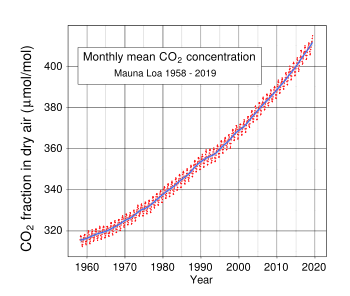Carbon Capture
March 2, 2020
Tikalon's home in
northern New Jersey is located in one of the colder parts of the
contiguous United States. Our
house is
heated by
natural gas; and, although it's a smaller house by
suburban New Jersey standards and well
insulated, it still takes a lot of
energy to
heat. One reason for this is that it's a traditional
ranch-style house with all
rooms on a single
floor, so there's no passive heating of a lower floor to an upper floor.
Our monthly natural gas
bill conveniently includes the energy usage in
therms. A therm is equal to 100,000
British thermal units (BTU), a non-
SI unit that's commonly used to describe heating and
cooling in the
United States. One therm is obtained through the
combustion of nearly 100
cubic feet of natural gas. In terms more common to
scientists and
engineers, a therm is equal to 25,200
kilocalories (
chemistry), 105.5
megajoules (
physics), or 29.3
kilowatt-hours (
electrical engineering).[1]

Natural gas therms used for heating our home in 2019. The total usage in 2019 was about 1,350 therms. Natural gas use in warmer months is for heating water and to fuel a backup electrical generator. (Graphed using Gnumeric. Click for larger image.)
I've been familiar with the
concept of
carbon capture and sequestration for more than a
decade. My 2012
science fiction novel,
Mother Wode, has a
scene in which an
evacuation caused by an
alarm at a carbon sequestration
plant is used as a cover for the
physical hacking of some
desktop computers. At that time I
investigated how
homeowners might take charge of their own
carbon emissions by capturing the carbon right at their home. My
assumption was that a capture device shouldn't be any larger than the
furnace creating the emission. The captured carbon might somehow be
buried in the
backyard of my third
acre lot.
One quick
calculation quickly killed that
idea. Combustion of a therm of natural gas produces about 5.3
kilograms (11.7
pounds) of
carbon dioxide. Ignoring the fact that we've captured carbon dioxide, and not carbon itself, five kilograms of
graphite (
density about 2.1
grams/
cc) would occupy 10,500 cc. Our 1,350 therm
annual natural gas usage would produce about 14 million cc of graphite, or 14
cubic meters. This would be a
cube 2.4
meters (7.9 feet) on a
side.
Since this
residential point-of-emission solution is clearly
untenable, what are the options? A
retrofit to all
electric heating would allow the sequestration to happen at the
power plant if
combustion fuel sources are used. Ideally, the
electricity would be generated using
renewable energy sources, such as
hydroelectric,
solar and
wind. Such a major change would require a change in the
electrical distribution infrastructure, since the
power lines feeding homes in my area are not designed for everyone to take that much power.
That would be the case if a house required 1,350 therms
annually for heating; but, proper thermal
design can reduce this heating considerably. I wrote in an
earlier article (Thermal Filtering, January 21, 2019), that there's an
interesting anecdote about
radio astronomy pioneer,
Grote Reber. Reber built a
radio telescope at his home in
Wheaton, Illinois, in 1937, but he moved to
Tasmania in his later years to conduct radio astronomy at
very low frequencies. It's recalled that his Tasmanian house, built with eight inch thick
walls and
double-glazed window panes, was so well insulated that use of the
kitchen oven would bring the room to 120 °F (50 °C).

Atmospheric carbon dioxide concentrations at Mauna Loa, Hawaii, 1958-2018. This curve is known as the Keeling curve.
The data, shown in red, demonstrate the seasonal variations in carbon dioxide caused by land plant uptake. The blue curve is a smoothed trend.
(Wikimedia Commons image, Data from R.F. Keeling, S.J. Walker, S.C. Piper, and A.F. Bollenbacher, reformatted for clarity. Click for larger image.)
In a recent issue of
APS News,
Amory Lovins,
chair of the
Rocky Mountain Institute, describes the design of his own house near
Aspen, Colorado, where temperatures can get as low as 44 degrees below zero
Celsius.[2] His house, constructed in 1983, uses no combustion heating. Just as in Reber's house, it is heavily insulated and has windows with very low heat loss.[2] Its heating is accomplished almost entirely by
passive solar heating, with an additional 1% done by active solar heating.[2] Savings in the
capital and
operating costs of conventional heating allowed a
payback for the
energy efficiency add-ons used in the construction in less than a year.[2]
There's an old
saying, "
Put your money where your mouth is." At a recent
luncheon with my former
corporate research colleagues, we were talking about how much of a
financial hit we might take if we wanted to mitigate our personal
carbon footprint. The
2016 per capita carbon dioxide equivalent for the United States was 17.75
metric tons. I didn't know this figure at that time, so I
estimated just the cost of mitigating the 7 metric tons of carbon dioxide from my natural gas usage. My estimate was that it would take about two thousand dollars and I would be willing to absorb this cost for the benefit of my
children and
grandchildren.
The
technology for offset of all my present carbon emissions is
direct air capture in which carbon dioxide is captured directly from the
ambient air. One advantage of this method is that direct air capture plants can be sited anywhere. Another advantage is that it's a path to
negative emissions in which we might reduce atmospheric carbon dioxide rather than just stabilizing it. Carbon dioxide can be extracted my various means, including
chemical containment in a
liquid solution of
sodium hydroxide or
amines,
semi-permeable membranes, and
metal-organic frameworks. The major problem is that vast amounts of air need to be passed through a direct air capture system, since the atmospheric concentration of CO
2 is just 400
ppm. I'm reminded of the
Barsoom atmosphere plant in the
Edgar Rice Burroughs' novel,
A Princess of Mars.

Don't worry, Princess! I'll save you from global warming!
According to the summary at Fandom.com, the Barsoom (Mars) atmosphere plant converts solar radiation to the air necessary to sustain life on the planet.
It's a huge and highly fortified installation, four square miles in area and 200 feet in height.
(A 1917 cover illustration by Frank Schoonover for A Princess of Mars, via Wikimedia Commons.)
In 2011, the
American Physical Society published a report on direct air capture that estimated the cost at $641-$819 per ton of CO
2.[3] By that estimate, the capture cost for my 7,155 kilograms of carbon dioxide from natural gas usage would be nearly $6,000, quite a bit larger than my $2,000 lunchtime estimate. However, costs have been reduced over the years to about $100 per metric ton, which is well within my
budget.[4] An early entry into this
industry is
Global Thermostat, which has a
pilot plant in
Huntsville, Alabama.[5] Global Thermostat uses amine-based
absorbents for CO
2 removal, and it claims a cost of just $120 per metric ton at its Huntsville facility.
Global Thermostat's CO
2 ends up as
soft drink carbonation.[5] There exists an established billion dollar CO
2 market for things such as
carbonated beverages, a
stimulant for
greenhouse plant growth, and for
enhanced oil recovery.[5] Carbon dioxide is
miscible in
petroleum and it lowers its
viscosity, which is an aid to extraction.[6] Carbon dioxide is worth $100 per metric ton in this market,[5] but you can't count on that money after direct air capture produces more CO
2 than needed.

Estimate by the National Academies of Sciences, Engineering, and Medicine of carbon dioxide removal needed to attain net zero carbon emissions by 2090 while keeping global warming below 2°C. Some carbon capture will be needed even after 2090 to mitigate problematic or expensive sources of carbon dioxide, such as those from agriculture, land-use change, and aviation fuels. (Created using Inkscape from data in fig. 8.1 of ref. 4.[4] Click for larger image.)
There's been a growing interest in carbon capture, as indicated by the
rate of publication of articles on this topic, including a lengthy article in the January, 2020, issue of
Physics Today.[6] The article reports on a major
investment in Global Thermostat by
ExxonMobil, and a
partnership with another DAC startup,
Carbon Engineering, by
Occidental Petroleum in the design of a plant with the capability of extracting a million tons of CO
2 from the atmosphere annually.[6] As a cost check, the
Swiss company,
Climeworks, sells small-scale
commercial DAC systems suitable for CO
2 supply for applications such as greenhouses with a cost of $600/ton and an expected cost reduction to $200/ton in three years.[6]
One problem, of course, is that DAC plants need energy to operate. If this energy does not come from carbon-free sources, the actual cost per ton is higher, since its own carbon use needs to be mitigated. Energy is needed for the giant
fans that drive air through the system, extracting the CO
2 from the absorbents,
compressing the CO
2 and
transporting it to storage sites,[6] One study referenced in the Physics Today article estimates that DAC might require a quarter of the
world's total energy demand by 2100.[6] A technology under study at
Arizona State University involves a less energy-intensive concept of
artificial trees with
leaves that contain an ion exchange resin for carbon capture.[6] Such artificial trees would be hundreds of times more
efficient at capturing CO
2 than
Amazon rainforest trees.[6]
As I wrote earlier in this article, carbon capture is just the first part of a process that requires storage of the captured carbon. One option is to
pump the captured CO
2 into the
pores of
sedimentary rock. The
United States Department of Energy estimates that the total sedimentary rock storage capacity for CO
2 in the United States alone could be as high as 22 trillion tons, with an equivalent capacity in
China.[6] That's enough for storage of 600 years of current CO
2 emissions.[6] The additional transport and storage costs are between $12-$50 per ton.[6]
References:
- United States Environmental Protection Agency, Greenhouse Gases Equivalencies Calculator.
- Amory B. Lovins, "The Back Page - Integrative Design for Radical Energy Efficiency," APS News, vol. 29, no. 1 (January, 2020).
- R. Socolow, M. Desmond, R. Aines, J. Blackstock, O. Bolland, T. Kaarsberg, N. Lewis, M. Mazzotti, A. Pfeffer, K. Sawyer, J. Siirola, B. Smit, and J. Wilcox, "Direct air capture of CO 2 with chemicals: A technology assessment for the APS Panel on Public Affairs," American Physical Society, June 1, 2011 (PDF File).
- Negative Emissions Technologies and Reliable Sequestration: A Research Agenda, National Academies of Sciences, Engineering, and Medicine, The National Academies Press, 2019, https://doi.org/10.17226/25259. A free PDF file is available for download with guest registration.
- Eli Kintisch, "Can Sucking CO2 Out of the Atmosphere Really Work?" Technology Review, Oct 7, 2014.
- David Kramer, "Negative carbon dioxide emissions," Physics Today, vol. 73, no. 1 (January, 2020), pp. 44-51, https://doi.org/10.1063/PT.3.4389. This is an open access article with a PDF file here.
Linked Keywords: Tikalon; home; northern New Jersey; contiguous United States; house; central heating; heated; natural gas; suburb; suburban; New Jersey; thermal insulation; insulated; energy; heat; ranch-style house; room; floor; invoice; bill; therm; British thermal unit; International System of Units; SI unit; cooling; United States; combustion; cubic foot; cubic feet; scientist; engineer; calorie; kilocalories; chemistry; megajoule; physics; kilowatt-hour; electrical engineering; summer; warmer months; water; fuel; electrical generator; Gnumeric; concept; carbon capture and storage; carbon capture and sequestration; decade; science fiction; novel; Mother Wode; plot (narrative); scene; emergency evacuation; alarm signal; factory; plant; hacker (computer security); physical hacking; desktop computer; research; investigation; homeowner; greenhouse gas; carbon emission; presupposition; assumption; furnace; bury; buried; backyard; acre; land lot; calculation; idea; kilogram; pound (mass); carbon dioxide; graphite; density; gram; cubic centimeter; cc; year; annual; cubic meter; cube; meter; edge (geometry); side; residence; residential; untenable; green retrofit; electric heating; power station; power plant; fossil-fuel power station; combustion fuel source; electricity; renewable energy; hydroelectricity; hydroelectric; solar energy; wind power; electric power distribution; electrical distribution infrastructure; overhead power line; power line; design; anecdote; radio astronomy; innovation; pioneer; Grote Reber; radio telescope; Wheaton, Illinois; Tasmania; very low frequencies; wall; insulated glazing; double-glazed window pane; kitchen; oven; atmospheric carbon dioxide concentrations at Mauna Loa, Hawaii, 1958-2018 (Keeling curve); atmospheric carbon dioxide; concentration; Mauna Loa, Hawaii; curve fitting; Keeling curve; data; season; seasonal; vegetation; land plant; smoothed trend; Wikimedia Commons; R.F. Keeling, S.J. Walker, S.C. Piper, and A.F. Bollenbacher; American Physical Society; APS News; Amory Lovins; chairman; chair; Rocky Mountain Institute; Aspen, Colorado; Celsius; passive solar building design; passive solar heating; capital (economics); operating cost; payback period; efficient energy use; energy efficiency; saying; Put your money where your mouth is; lunch; luncheon; research and development; corporate research; colleague; finance; financial; carbon footprint; greenhouse gas emissions per capita; carbon dioxide equivalent; metric ton; approximation; estimate; child; children; grandchild; grandchildren; technology; direct air capture; ambient; chemical compound; aqueous solution; liquid solution; sodium hydroxide; amin; membrane; semi-permeable membrane; metal-organic framework; parts per million; ppm; Barsoom; atmosphere plant; Edgar Rice Burroughs; A Princess of Mars; Princess; global warming; Fandom.com; Mars; sunlight; solar radiation; atmosphere of Mars; air; life; planet; fortification; fortified; square mile; area; height; book cover; illustration; Frank Schoonover; scientific literature; publish; budget; industry; Global Thermostat; pilot plant; Huntsville, Alabama; absorption (chemistry); absorbent; soft drink; carbonated drink; carbonation; market (economics); stimulant; greenhouse; plant development; plant growth; enhanced oil recovery; miscibility; miscible; petroleum; viscosity; National Academies of Sciences, Engineering, and Medicine; greenhouse gas; carbon emissions; agriculture; land-use change; aviation fuel; Inkscape; frequency; rate; Physics Today; investment; ExxonMobil; partnership; Carbon Engineering; Occidental Petroleum; Switzerland; Swiss; Climeworks; commerce; commercial; fan (machine); compressor; compressing; transport; transporting; world energy consumption; world total energy demand; Arizona State University; efficiency; efficient; Amazon rainforest; pump; porosity; pore; sedimentary rock; United States Department of Energy; People's Republic of China; United States Environmental Protection Agency, Greenhouse Gases Equivalencies Calculator.